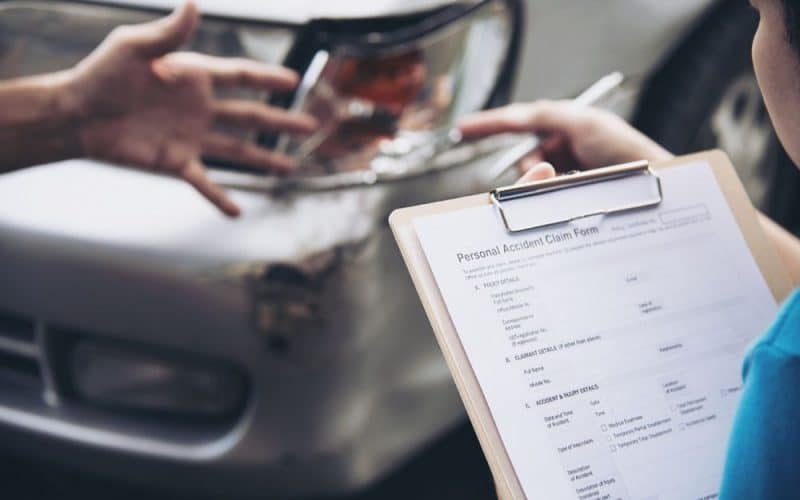The car insurance claims process is a simple and straightforward one. A car insurance claim is a formal request made by a policyholder to an insurance company for coverage or compensation for a covered accident.
When a policyholder is involved in an accident that is covered by their insurance policy, they submit a claim to the insurance company to seek reimbursement or payment for the damages or expenses incurred.
What does an insurance claim cover?
What your insurance claim will cover depends on the type of insurance you have. Here are a few types of insurance coverages:
- Bodily injury. Bodily injury covers any medical injuries that you cause to another driver. The other driver will file a claim with your insurance company to access these benefits.
- Property injury. Property injury covers any property damages that you cause to another driver. Again, the other driver will contact your insurance company for this.
- Comprehensive. A comprehensive policy covers damages to your own vehicle that are not due to an accident. This may include theft, vandalism, a tree falling on your vehicle, or flooding.
- Collision. A collision policy covers damages to your own vehicle that are due to an accident, even if you are at fault. You will file an insurance claim with your own provider to access benefits.
What to do after a car accident?
Accidents are unexpected and they tend to confuse us. If you are in an accident, these things can help you raise a claim more effectively:
- Immediately assess yourself and your car for damages. Based on your condition, decide whether you require medical assistance or not.
- Try to note the details of the other party, in case another vehicle is involved in the accident. This will help identify the other party sooner.
- If possible, take down the contact details of witnesses in the vicinity as they can corroborate your account.
- Inform your insurance company and request for a surveyor.
- If you have access to a partner garage, you can now choose the cashless claims option to ease the process.
- Most insurers require claims to be raised within 24 hours of the accident, so ensure that you do not delay this.
- Keep all the required documents handy to ensure that your claim gets processed as soon as possible.
What does the car insurance claims process entail?
The main purpose of purchasing an insurance policy is to ensure that in your moment of need, the insurance money can help you meet the associated expenses. From that perspective, when it comes to insurance, the ‘moment of truth’ is defined by the ease of the claims and settlement process.
Once you decide to buy a car and subscribe to a comprehensive insurance cover, you may be concerned about how to go about the claims process in case of an accident or any other untoward incident. Here is a detailed analysis of all the things you must keep in mind when it comes to the car insurance claims process.
First of all, an insurance claim is an official request, from the policyholder to the insurance provider, demanding compensation for the damage or loss incurred. Once the claim is processed and verified, the insurance provider offers compensation according to the coverage guaranteed to the customer, under the insurance agreement.
Types of car insurance claims
You can make your insurance claim in two ways – cashless method or reimbursement method.
If you get your car repaired at a partner garage after an accident, then your insurance claim is settled in a cashless manner. Insurance companies have tie-ups with garage chains. This is why it is best to inquire about which garages are partnered with your insurance company, so you can get the best and quickest claim resolutions.
In this scenario, the insurance provider makes direct payments to the partner garage, making it more convenient.
However, if you repair your car at a garage that is not partnered with your insurance provider, you will have to make the payments and get the bills. After this, you can get the repair bills reimbursed by the insurance provider.
Reimbursement claims can also be filed when you have third-party claims against you. If you pay the third party directly, you can get a reimbursement from your insurance provider, depending on the terms and conditions mentioned in the policy.
Documents required when filing a car insurance claim
Based on the nature of your claim, you will be required to submit all or some of the following documents:
- Copy of your car insurance policy
- Copy of your driver’s license
- Copy of your car’s registration certificate
- First Information Report (FIR)
- Estimate of the damages and repairs
- Medical report (only in case of physical injuries)
- All records of other expenses which are being claimed
- Photographs if available
How to file a car insurance claim
When you have a car accident, contact your insurer as soon as possible. Some policies have time limits for claiming. Also ask them if you’re entitled to any emergency benefits, for example, free car hire or accommodation.
Gather information about the accident
To make a claim, you have to meet the terms and conditions of your policy.
If your accident involved another car, your insurer may ask for details of the other driver, including:
- contact details (name, address, phone number)
- driver’s licence and car registration
- insurance company
- car make, color and model
Your insurer may also ask for:
- the location of the accident
- a description of what happened and any damage to cars or property (plus photos)
- a police report number (if the police attended or you reported your car stolen or damaged)
- details of the tow truck company (if one attended)
- contact details of any witnesses
Check what you can claim for
Check your policy to find out what you can claim for. For example, if you have third-party insurance, you can only claim for damage to other cars. Also, check if there are any exclusions to your cover. You may not be covered if the person driving your car was under the influence of alcohol or drugs, or if your car was unregistered.
Check if you have to pay an excess
Generally, you have to pay an excess when you make a claim whether you’re at fault or not. Some policies will waive the excess in limited circumstances. Check your policy’s Product Disclosure Statement (PDS) for the excess amount and conditions where it might be waived.
Make a claim
There are different rules and processes for claiming. Check the claims process on your insurer’s website.
If you do decide to claim, you’ll need to fill out a claim form. You may be able to do this with your insurer over the phone or online. Ask your insurer if you can start a claim to find out how much the repairs will cost. Then you can decide if it’s worth going ahead. For example, if the damage is minor, the repairs may cost less than your excess.
If the other party has admitted it was their fault, their insurer may pay for your costs.
After you make a claim
After you’ve made your claim, the insurer must contact you within 10 business days. They may accept or reject your claim, or ask for more information. If they reject your claim, they must do this in writing.
Your insurer may contact any other drivers, their insurers, and any witnesses who saw the accident. They may also investigate to confirm the details of what happened and who was at fault.
If you’re not happy with how your insurer has handled your claim, make a complaint to their Internal Dispute Resolution team.
Car insurance claims process for damages to personal vehicles
You will have to follow these steps while filing a claim for damages to your own car:
- First, you must make sure that you inform your company in advance before sending your car to the garage for repairs. Once you do this, the company will send a surveyor to examine and verify the damages, making it easier to get the claims reimbursed. You and your insurance provider will both receive copies of the examiner’s report, offering evidence of the damage caused and an evaluation of the extent of damages.
- Second, you must fill and submit the designated claim form to your insurance provider. This can be done both online and offline. However, you must ensure that you do not leave out any important details.
- Third, along with the form, you must submit the requested documents which usually include a copy of your driving license and car registration certificate. In the case of theft or highway accidents, you must also submit a copy of the FIR filed with the police.
- Once the car is repaired and you receive the bill, you should submit a copy of the bill to supplement your claim.
- Following the examination and verification of all the documents, the insurance company will process the claim and reimburse you for the damages incurred.
Car insurance claims process for third-party damages
In case you have been a part of an accident that has caused injury to third-party or damage to third-party property, you can follow these steps to file the claim:
- Inform your insurance company as soon as you receive the claim notice. Along with this, also submit the registration certificate of your car, your driving license, and the FIR filed with the police.
- The insurer will provide you with the services of a lawyer once the documents are verified.
- Once the case goes to court, if you are found liable to pay damages, your insurer will make the payment on your behalf, in line with the sum insured.
Car insurance claims process for theft
If your car has been stolen, you can take the following steps to file a claim with your insurance provider:
- First, as soon as possible, lodge a police complaint and file an FIR. Once this is done, send a copy of the FIR to your insurance company. Along with this, also send a copy of the final police report along with the registration certificate.
- Once the documents are verified, and all the formalities are completed, the insurance company will reimburse you for the sum insured.
Why do some car insurance claims process take longer?
The more serious the accident or incident that led up to the claim, the longer the claim (and the payout) will take. Companies can process some claims more quickly than others when there are fewer details and people involved in the claim.
Here are a few of the biggest reasons:
- The severity of the injuries. If a driver is badly injured in a car accident, expect the settlement to take longer. The driver has to finish treatment in order to determine how much money they can get.
- Dispute over which driver was responsible. After an accident, it’s not always immediately clear who was responsible. If there is a dispute about each driver’s negligence, it’s going to take the insurance companies longer to settle the claim.
- Back-and-forth negotiations. In general, settlement negotiations can take a lot of time. There’s usually a good amount of back-and-forth between lawyers, victims, and the car insurance companies.
However, there are laws against undue claims delays. An insurance company needs to provide a payout within a certain number of days from the time the claim is settled and everything is finalized.
It’s also important to mention that some insurance companies are just slower to pay out claims than others. For example, if you work with a small insurance carrier that only has one adjuster, it could take much longer to receive your payout. Large insurance companies have teams of adjusters who work to resolve claims all day long.
Your participation can also affect how quickly you’ll get paid for a car insurance claim. If your claims adjuster asks you for documents and you take days to get it to them, it will slow the process down.
Recommended Articles
- At-Fault Accident: Everything You Need To Know
- Can You Drive Without Insurance? All You Need To Know
- Car Totaled Insurance: All You Need To Know
- How To Check Car Insurance: The Ultimate Guide
- Insurance For Uber Drivers: How It Works & Top Providers
- How Long Does Insurance Claim Take To Settle?






